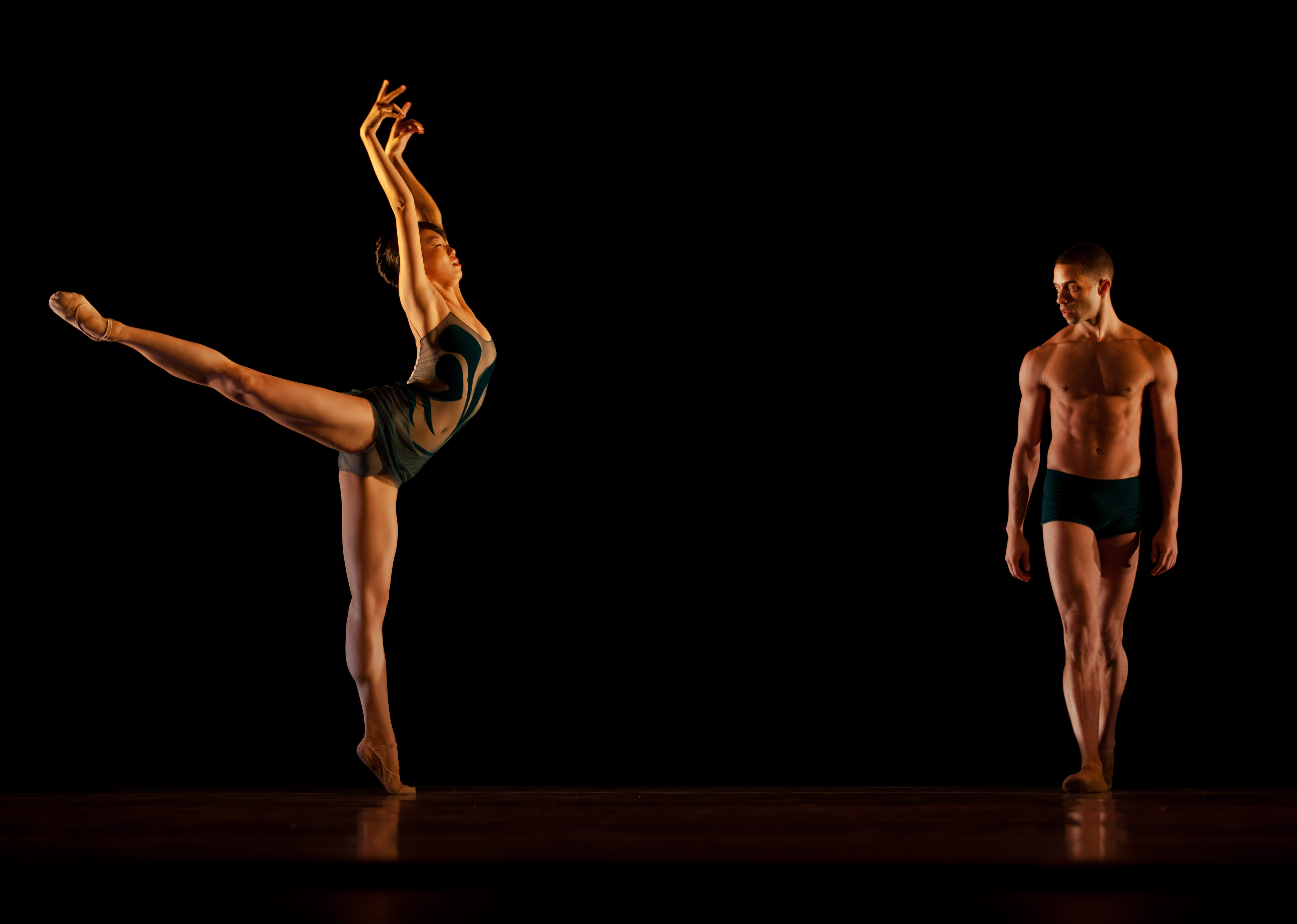BY LUCIA CHUNG
Award-winning choreographer Alonzo King is famous for his ability to express global traditions through contemporary ballet. For the 2011 Fall Season, which runs at the Novellus Theatre in the Yerba Buena Center for the Arts through Sunday, October 23, LINES Ballet kicks off the show with the premiere of Resin, a piece that’s set to Sephardic music, and ends the night with 1998’s Who Dressed You Like a Foreigner?, which is set to tabla music by Zakir Hussain. After the show this past Wednesday, Alonzo King sat with the audience for a Q&A session, where he remarked on the ubiquitous, all-encompassing nature of art and artistry and the fulfillment it provides. He also made a self-affirming comment to the audience: “We are all gods.” Based on what I saw that night, I am inclined to agree.
 Yujin Kim and Ricardo Zayas. Photo by Quinn B. Wharton. Courtesy of Mona Baroudi PR.
Yujin Kim and Ricardo Zayas. Photo by Quinn B. Wharton. Courtesy of Mona Baroudi PR.
Resin is an intricate, beautiful and complicated piece that is rife with meaning. However, the ballet was immensely enjoyable from a purely aesthetic standpoint as well, since the lines created by the dancers’ bodies are simply breathtaking to behold. From the very start of the piece, when Victor Mateos Arellano pressed himself against a cloth cocoon, I was struck by how incredibly alone he looked, but also by how incredibly ripped he is (the cloth that shrouded him brought his body into sharp relief). Oddly enough, that dynamic between struggle/beauty and loneliness/strength precisely represented the dominant theme that pervaded the piece.
A compilation of 14 shorter pieces choreographed to 13 songs (one of the sets is silent), the feeling of sorrow in Resin perhaps originates from the music. Resin narrates the journey of the Sephardic Jews, who were expelled from the Iberian Peninsula around 1492. However, the tragedy of this diaspora resulted in music that is undeniably rich–the songs that King chose to use come from Sephardic communities that span from Morocco to Yemen. The name of the piece is also symbolic. The program notes that hardened lumps of raw resin, which are harvested from deeply slashed trees, are referred to as “tears.” That evocative image of pain sharply contrasts with resin’s practical applications, as the substance is used to create sweet-smelling incense, or rubbed onto the hairs of violin bows so that the resulting friction can help create gorgeous sounds. King takes these contrasting ideas and puts them into dance. The end result is a portrayal of the Sephardic Jews’ lonely struggle in which a sense of their perseverance, beauty and strength comes singing through. This dichotomy of opposing emotions creates a friction that results in a charged, heartfelt performance.
 Victor Mateos Arellano. Photo by RJ Muna. Courtesy of Mona Baroudi PR.
Victor Mateos Arellano. Photo by RJ Muna. Courtesy of Mona Baroudi PR.
By having only a few dancers occupying the stage at a time (the company consists of 12), these people are not only portrayed as isolated and alone during this diaspora, but also as incredibly strong and almost stoic. The entire company is rarely on stage together, and the performance often focuses on just one dancer, or on a pair of intertwined dancers who sometimes support each other, sometimes struggle with one another. When multiple dancers are on stage, they sometimes form a community where they simply watch as a single dancer performs–but each dancer always ends up leaving the stage alone. The seamless way the dancers staidly enter and exit the stage, as if the audience were catching them in the midst of an endless cycle, holds everything together. Watching the story unfold before me, I couldn’t help but be thralled by the profound sense of strength imparted by the grace and power behind each of the dancers’ regal movements. I thought to myself, “Yes, these people are isolated, but they are more than capable of standing alone. They are beautiful.”
 Yujin Kim. Photo by Quinn B. Wharton. Courtesy of Mona Baroudi PR.
Yujin Kim. Photo by Quinn B. Wharton. Courtesy of Mona Baroudi PR.
The most striking scene for me occurs towards the end of the piece, when a wall of sand cascades down from the back of the stage in near darkness. A single spotlight highlights a corner of the front of the stage, where there is also a trickle of sand coming from above. Under this spotlight, Meredith Webster twirls in place with one other dancer, while the rest of the company move in slow motion behind them, simply walking across the stage, tired, but still moving forward.
 Victor Mateos Arellano. Photo by RJ Muna. Courtesy of Mona Baroudi PR.
Victor Mateos Arellano. Photo by RJ Muna. Courtesy of Mona Baroudi PR.
If you have a chance to see the ballet, go. Thought-provoking and deeply touching, Resin and Who Dressed You Like a Foreigner? are both enriching and deeply inspiring.
RELATED LINKS
Did you see Resin? Tell us what you thought! Let us know what you think! Follow us on Twitter and like us on Facebook to give us a shout. You can also stay on top of exciting events from around the world by downloading the eventseeker app for iPhone, Android or Windows.
